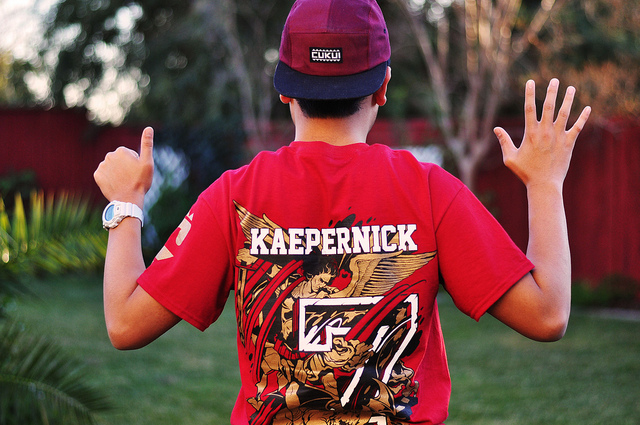Unlock the Magic in Your Story Now
Get the Free 20 questions to Ask Before Launching Your Idea workbook when you sign up for occasional updates.
Get the Free 20 questions to Ask Before Launching Your Idea workbook when you sign up for occasional updates.
Articles filed in: Storytelling
The Obvious Advantage
filed in Storytelling, Strategy
 The owner of our local organic store has built a thriving business. It’s the go-to place for people from the suburb who are happy to invest in a story about the benefits of eating well. He’s recently opened a new store in another suburb but hasn’t been able to replicate the success of the first. One of the sales assistants I spoke to has a theory about why the second branch isn’t doing so well. It all comes down to the story people believe before they set foot in the store.
The owner of our local organic store has built a thriving business. It’s the go-to place for people from the suburb who are happy to invest in a story about the benefits of eating well. He’s recently opened a new store in another suburb but hasn’t been able to replicate the success of the first. One of the sales assistants I spoke to has a theory about why the second branch isn’t doing so well. It all comes down to the story people believe before they set foot in the store.
It’s obvious from the street that store one sells health food and sustainable products. Everything from the location, signage and ambience gives a prospective customer clues about what to expect when they get inside. The second branch is bigger than the first. It has a cafe located at the front. The interior design is sparse and industrial. The products aren’t visible until you’re deep inside. It looks and feels just like any other grocery store and cafe. The result is that people are confused about what the place is and who it’s for.
If we build it, they will come—but only if we’re explicit about who it’s for and why it’s for them.
Image by Sascha Kohlmann
The Story Of Successful Ideas
filed in Marketing, Storytelling, Strategy
 Every product or service that becomes the backbone of a thriving business succeeds because it enables someone to do something they want to do, but can’t do.
Every product or service that becomes the backbone of a thriving business succeeds because it enables someone to do something they want to do, but can’t do.
Before Keep Cup, millions more disposable coffee cups ended up in landfill.
Before Stripe, it was more difficult for people and businesses to receive payments over the internet.
Before Zumba, exercising was less fun.
Before Shopify, launching an online store was costly and complicated.
Before Blue Apron, putting a home-cooked meal on the table was more time-consuming.
Before Amazon, shopping online was less convenient.
Your product should bridge the gap between your customer’s imperfect present and her imagined future. And your marketing must tell the story of how her life will be changed in the presence of your product. Who is your customer before she encounters your product, and who is she after?
Image by Jinn
Good Is The New Average
filed in Marketing, Storytelling, Strategy
 Meeting expectations was once enough to mark a business out. If every meal was served piping hot, served in a timely fashion, with a smile—the restaurant owner won. Now, efficiency is expected. It’s the minimum requirement for operating any business.
Meeting expectations was once enough to mark a business out. If every meal was served piping hot, served in a timely fashion, with a smile—the restaurant owner won. Now, efficiency is expected. It’s the minimum requirement for operating any business.
Good is the new average. Only the exceptional will survive and thrive.
Your goal isn’t just to satisfy customers. It’s to give them a story to tell. What is that story?
Image by Frédéric Poirot
Making Sense Of Nike’s Controversial Ad Campaign Decision
filed in Storytelling, Strategy
 Unless you’re an American football fan, you probably hadn’t heard of Colin Kaepernick before August 2016. Kaepernick, an African American, was a quarterback for the San Francisco 49ers when he was propelled into the media spotlight for choosing to sit (then later kneel), during the United States national anthem at the start of NFL games. Kaepernick was protesting racial injustice and alleged police brutality towards African Americans. His controversial actions divided the nation.
Unless you’re an American football fan, you probably hadn’t heard of Colin Kaepernick before August 2016. Kaepernick, an African American, was a quarterback for the San Francisco 49ers when he was propelled into the media spotlight for choosing to sit (then later kneel), during the United States national anthem at the start of NFL games. Kaepernick was protesting racial injustice and alleged police brutality towards African Americans. His controversial actions divided the nation.
In a proud and patriotic country, Kaepernick’s protest was seen by some (including the president) as an insult to the flag and its military. To many, he became a hero. Despite the controversy surrounding Kaepernick ‘taking a knee’ during the anthem, other players followed his lead. Their pregame protests began to dominate the news during 2017 when the country’s president publicly criticised the players’ actions. Ultimately Kaepernick, who was thrust into the international spotlight, as a result, paid a heavy price for his activism, opting out of his 49ers contract early because he believed they did not intend to renew it. At the time of writing, he has yet to be signed by another team.
On 3rd September 2018 Nike revealed their new advertising campaign, featuring Kaepernick. The words, ‘Believe in something. Even if it means sacrificing everything,’ followed by Nike’s, ‘Just do it,’ slogan, appeared on billboards across America. The reaction in the media and on social media was immediate. People who were deeply opposed to his stance and his activism took to social media to criticise the company. The U.S. president questioned what Nike was thinking in a tweet. Experts debated the wisdom of Nike’s decision to make Kaepernick the face of their campaign. Analysts watched the company’s share price and sales—looking for confirmation that its new, seemingly risky marketing strategy had harmed their brand.
Among all the speculation and the noise, one story seemed to confirm Nike’s foolhardiness. A former Nike customer, Sherry Graham-Potter posted an open letter to the company on Facebook, objecting to their portrayal of Kaepernick as a hero. In the letter, she wrote about how her life had been devastated the night her husband, a police officer, was killed by a vehicle while in pursuit of a suspect on foot. The couple had only been married a month. Their two young sons (from her previous relationship), who her new husband had raised as his own were bereft. Mrs Graham-Potter went on the describe how her husband’s death had left her broken. She couldn’t eat. She barely left the house. Then she told the story of the moment when she found the courage to go on. Even as she was grieving, Mrs Graham-Potter realised she had to do something. She had to move her body. So, she put on her Nike cap and went for a short run. For those few moments on the road, she felt like a ‘normal person’, and that feeling kept her going.
Here’s some of what she wrote;
“That black cap became a symbol to me, it is sweat-stained and its shape is gone, the buckle in the back barely closes; but that hat represents my family’s rise from the ashes. It stands for the strength and the sacrifice we made loving a man who had a job that we all knew could end his life, every time he walked out that door. And it did. And I accept that.
I still wear this hat, I wore it on my run this morning.
And then I heard about your new ad campaign.”
I quote Mrs Graham-Potter here, to show how the campaign divided Nike customers. But also to point out that what the Nike brand symbolised for her at her lowest moment aligns with the company’s mission. And to perhaps shed some light on the reasons why Nike was willing to take the risk of making Kaepernick the face of their campaign.
Nike’s mission is, ‘to bring inspiration and innovation to every athlete in the world.’ The company’s conviction is that they have the power to change how people feel about what they can achieve when they wear the Nike logo. Shelly Graham-Potter’s heartfelt words about how she gained strength from that Nike hat likely gave the team at Nike the courage to weather the storm surrounding the Kaepernick campaign. Nike’s decision about what story to tell was based on their beliefs about who they are as a company and the change they’re here to create for whom. They followed through on that, knowing that their decision would polarise people.
Marketing analyst, Professor Scott Galloway, declared Nike’s decision as ‘genius’—the ‘most gangster marketing move of 2018’. According to Galloway, the Kaepernick campaign also stacks up commercially. He estimates that of Nike’s $35 billion in annual revenue, $20 billion is generated overseas. Two-thirds of Nike consumers are under 35 years old. They are likely to live in urban areas and have above average disposable income and a progressive worldview. Extrapolating from this data, Galloway says that Nike risked $1-3billion in revenue to deepen the brand’s connection with customers who represent $32-$34 billion in revenue.
We sell storytelling short when we think of it as only the means to get attention. Stories, well-told are the way we make an emotional connection with the people who believe what we believe—which is why the most successful brand stories aren’t for everyone.
Image by Michael Casim
Thanks to Lori Fields who inspired this post.
The Art Of Differentiation
filed in Storytelling
 One day you will find a design you laboured over, taken and copied or several lines of copy you crafted, used and unattributed. And you will rant and rave until you realise, that there are things you can say and do that can’t be copied because those things are only true for you.
One day you will find a design you laboured over, taken and copied or several lines of copy you crafted, used and unattributed. And you will rant and rave until you realise, that there are things you can say and do that can’t be copied because those things are only true for you.
We spend billions of dollars every year trying to differentiate ourselves and the things we make serve and sell, often ignoring that what makes us different is the thing that’s closest to home. The truth that nobody else can own. The closer you can get to owning those truths, the more differentiated your brand will be.
Image by Michael Coughlan
Is The Consumer The Customer?
filed in Marketing, Storytelling
 When the Old Spice ‘Smell Like a Man’ advertising campaign launched eight years ago, it called out an often unspoken truth about sales and marketing. The consumer and the user are not necessarily one and the same. This insight inevitably alters how you tell the story of the products you sell and the change you’re trying to create.
When the Old Spice ‘Smell Like a Man’ advertising campaign launched eight years ago, it called out an often unspoken truth about sales and marketing. The consumer and the user are not necessarily one and the same. This insight inevitably alters how you tell the story of the products you sell and the change you’re trying to create.
We don’t only buy things that are useful. We often buy things because of the story they enable us to tell ourselves about the kind of pet owner, parent or partner we are.
Successful brand stories speak to the heart and the head of the decision-maker, who may not be the person (or animal) whose needs the product was designed to satisfy.
Image by David
The Attraction Retention Conundrum
filed in Storytelling, Strategy
 The line outside the new patisserie snaked around the block. It never seemed to get shorter. The word that they were giving away free muffins on opening day had travelled fast and the owner wasn’t sure she’d have enough for everyone. The launch promotion had worked that was for sure!
The line outside the new patisserie snaked around the block. It never seemed to get shorter. The word that they were giving away free muffins on opening day had travelled fast and the owner wasn’t sure she’d have enough for everyone. The launch promotion had worked that was for sure!
Now she just had to figure out how to keep people coming back.
What attracts any customer isn’t necessarily what keeps the right customer coming back. Getting people to notice or to try something new can feel like the hard part of building and marketing a business.
The hard part is creating something that draws people to you on a dreary, wet Wednesday because you made them feel like they belonged. Sustainable businesses and beloved brands build for day two customers—not only for the masses who show up on day one.
Image by Susanne
Show Your Story
filed in Marketing, Storytelling, Strategy
 In the early 1960s, a Brooklyn tax clerk, named Jean Nidetch discovered a powerful and underutilised marketing technique. When Jean, who had been overweight for years, lost thirty kilos her friends asked her how she’d done it. She began sharing her diet secrets with half a dozen friends in her apartment. Jean’s diet club soon outgrew the apartment. The before and after transformations of successful members were all the marketing that was required to convince people to join. It was from these humble beginnings that Weight Watchers was born.
In the early 1960s, a Brooklyn tax clerk, named Jean Nidetch discovered a powerful and underutilised marketing technique. When Jean, who had been overweight for years, lost thirty kilos her friends asked her how she’d done it. She began sharing her diet secrets with half a dozen friends in her apartment. Jean’s diet club soon outgrew the apartment. The before and after transformations of successful members were all the marketing that was required to convince people to join. It was from these humble beginnings that Weight Watchers was born.
The before and after photo has been used to market diet and beauty products for decades. And even though transformation stories would work in the marketing of services, we don’t use them often.
There is no better way to tell your story than to show people who they will become in the presence of your product. What was your customer’s life like before he used your product or service?
What’s his new reality?
That’s your story.
Image by Social Traders
Visible Vs. Memorable
filed in Storytelling, Strategy
 When my friend Mark opened his bakery, he was faced with a marketing dilemma. Should he blow his marketing budget on a single print advert that would cost him several thousand dollars or should he invest that money in something else? The promise of brand validation and the creation of mass awareness made the print advert tempting. But Mark wasn’t aiming to build a business that was more visible. He wanted to connect with his community around memorable experiences.
When my friend Mark opened his bakery, he was faced with a marketing dilemma. Should he blow his marketing budget on a single print advert that would cost him several thousand dollars or should he invest that money in something else? The promise of brand validation and the creation of mass awareness made the print advert tempting. But Mark wasn’t aiming to build a business that was more visible. He wanted to connect with his community around memorable experiences.
So instead of spending his marketing budget on conventional advertising, Mark created the weekly bread basket. The basket contained a week’s supply of delicious fresh bread which one lucky customer got to take home and enjoy. But here’s the best part. Each customer who received the basket nominated the next person to get one and recorded why they chose their friend or neighbour in a notebook at the bakery. The bread basket didn’t just spread the word about Mark’s bakery.
It connected friends and neighbours and made them feel like they mattered.
The kind of marketing we invest in sends a signal the kind of company we are aspiring to build. The immediacy of gaining awareness feels like progress.
But awareness isn’t what keeps customers coming back.
Image by scattered view
Sell It Like You Made It
filed in Storytelling, Strategy
 The days when you could go down to the Milofsky’s Hardware supplies, and come away with a couple of screws carefully wrapped in brown paper, which were perfect for the job, are long gone. The days when Mrs O’Hanlon didn’t mind taking this heavy glass jar, then that one, down from the shelves of her sweet shop for a kid trying to make her ten pence go as far as possible are long gone too. I miss them. We all do— even if we never lived them.
The days when you could go down to the Milofsky’s Hardware supplies, and come away with a couple of screws carefully wrapped in brown paper, which were perfect for the job, are long gone. The days when Mrs O’Hanlon didn’t mind taking this heavy glass jar, then that one, down from the shelves of her sweet shop for a kid trying to make her ten pence go as far as possible are long gone too. I miss them. We all do— even if we never lived them.
Many of us have the chance to sign our work—to put our name over the door figuratively. For many others, the work they do is anonymous. They don’t have the opportunity to put their name to it. But in either case, however you work and whatever you have a part in creating, building or selling, it’s made better when you sell it like you made it.
When we take ownership of our work, our story and the change we’re here to create the people on the receiving end know. And that sense that the product or service was made and sold with care and empathy and love makes the experience better. It makes us better too.
Image by Edna Winti